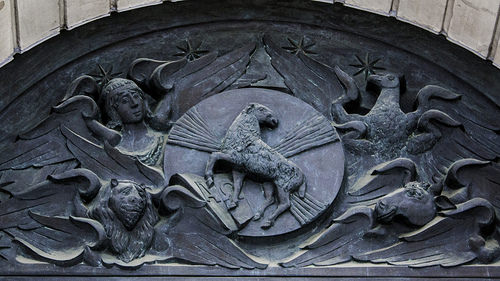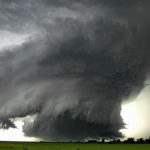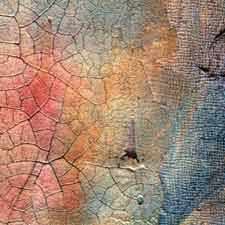We run our website the way we wished the whole internet worked: we provide high quality original content with no ads. We are funded solely by your direct support. Please consider supporting this project.

The Final Battle in Revelation
I will conclude this series on the violent imagery in Revelation by addressing the infamous eschatological battle scene found in 19:11-21, for it is this graphically violent section of Revelation that is most frequently appealed to by those who argue against the claim that Jesus reveals an enemy-loving, non-violent God that is unconditionally opposed to violence. (You can find part 1 of this series here, part 2 here, and part 3 here.)
Revelation 19 begins, not with an army preparing for battle, but with an army celebrating God’s victory in a battle that has already been fought (19:1-4). The inhabitants of heaven proclaim the truth that God has already defeated the prostitute (representing “the arrogance of the earthly power”) and has thereby already avenged the shed blood of his servants (19:1-4).
The only thing resembling a battle is one regarding the truth of the Lamb’s victory, known by the inhabitants of heaven (as we discussed in Part 3 of this series), to once-and-for-all vanquish the demonic deception that continues to oppress the inhabitants of the earth. The irony is that, while Revelation 19 is frequently appealed to as the clearest example of Jesus engaging in literal violence, in reality it does not depict a single violent act.
John utilizes traditional warfare imagery to imaginatively express this final battle between truth and deception, but, as usual, he completely transforms this imagery in the process. To cite one example, John applies to Jesus Isaiah’s macabre vision of Yahweh as a warrior wearing robes that are covered with blood (Isa 63:1-3; Rev. 19:13). In Isaiah’s vision, however, Yahweh is stained with the blood of his enemies whom he has trampled like grapes in a winepress in his “day of vengeance.” By contrast, Jesus’ robes are blood stained before he goes into battle, and the stains are from his own spilled blood as well as the blood of his martyred servants. It represents, once again, that Christ and his followers win by having their own blood shed rather than by shedding the blood of others.
Also in keeping with traditional apocalyptic symbolism, John depicts Christ wielding a “sharp sword” to “strike down the nations” (19:15). But it is extremely important to notice that the sword that Jesus wields comes out of his mouth (Rev. 19:15, 21; cf. 1:16; 2:26; 3:26). His weapon, clearly, is nothing other than the truth he speaks, which is why the title he rides into battle with is “Faithful and True” (19:11).
Finally, a word should be said about John’s lurid depiction of Jesus on a white horse “treading on the winepress of the fury of the wrath of God Almighty” (19:15). This is not John’s first use of this winepress imagery. The “great winepress of God’s wrath” is first mentioned in chapter 14 (vv. 19-20), and in this context John has significantly nuanced the details of the traditional imagery (See Is 63). While the traditional imagery depicts sinners being crushed like grapes because of their wickedness, John here depicts grapes being crushed simply because they are ready to be harvested (vv. 15,18). Moreover, while the traditional imagery identifies God’s judgment with the crushing of wicked grapes, John identifies God’s judgment with people drinking the wine that is formed from ripened crushed grapes (v.10). The crushed grapes express the wrath of God not because they are crushed, but because they form “the wine of God’s fury, which has been poured full strength into the cup of his wrath” (14:10; cf. 14: 8-9; 16:6; 17:6). God’s wrath is thus directed not toward the grapes, as it is in the traditional use of this imagery, but toward the unrepentant who are made to drink the wine that is a by-product of these grapes being crushed.
When we put this together with John’s pervasive theme that believers overcome by their willingness to be martyred, it suggests that the blood that flows from the winepress of God’s fury is not the blood of God’s enemies, but the blood of his servants whom these enemies murdered.
John’s use of the traditional winepress imagery provides yet another stunning example of how John turns violent imagery on its head by radically reinterpreting it through the lens of the self-sacrificial Lamb. Followers of the Lamb are called to participate in the war and to share in the victory of the Lamb, and we are called to do it the way the Lamb himself did it; namely, by choosing to love our enemies and suffer at their hands rather than to take up arms against them.
To conclude, John’s revision of traditional warfare imagery, with its stunning reassessment of power, “is so contrary to normal human practice that most churches throughout history have not agreed with John…”[1] I suspect that this is at least part of the reason why the genius of John’s transformation of violent imagery and the beauty of his non-violent, self-sacrificial message, have so rarely been grasped throughout history. To this day, it seems, the majority of Christians are more comfortable with a militant Messiah who slays our enemies than they are with a loving Messiah who would rather die out of love for his enemies and who calls us to do the same. For Christ’s sake and for the future of his church, one can only pray that the heart of this faith-professing majority would begin to change.
[1] S. Friesen, Imperial Cults and the Apocalypse of John: Reading Revelation in the Ruins (Oxford: Oxford University Press, 2001), 216.
Photo credit: Lawrence OP via Visual hunt / CC BY-NC-ND
Related Reading

Why Does God’s Activity Seem So Arbitrary?
Why? It’s the question that never goes away. Why is one infant born sickly and deformed when at the same time another is born perfectly healthy? Why does tragedy repeatedly strike one family while another seems to enjoy uninterrupted peace? On and on we could go with examples. It all seems so arbitrary and unfair.…

Quotes to Chew On: Religious Violence
“The myth of religious violence promotes a dichotomy between us in the secular West who are rational and peacemaking, and them, the hordes of violent religious fanatics in the Muslim world. Their violence is religious, and therefore irrational and divisive. Our violence, on the other hand, is rational, peacemaking, and necessary. Regrettably, we find ourselves forced to bomb them into the higher rationality.” ~William Cavanaugh,…

Quotes to Chew On: Conflicting Depictions of God
“This is something like the way I believe we should respond when we encounter biblical narratives that depict God doing things we can’t imagine Christ doing. For example, I can’t for a moment imagine Jesus—the one who made refusing violence and loving enemies a condition for being considered a child of God—commanding anyone to mercilessly…

Peaceworks
We’re excited about an upcoming video series by Peaceworks, a new youth movement for peace. It will inspire you and give you the tools you need to make a difference in your life and the world. Watch the trailer to find out who the speakers will be (spoiler alert: one of them is Greg) or visit…

Civilian or Soldier: Which Are You?
The Bible makes it clear that the people of God are to be on the offensive in storming the gates of hell (See post) and that Christians are to put on the armor of God (See post). However, in modern Western Christianity, it is much more common to behave more like civilians on a vacation than…

